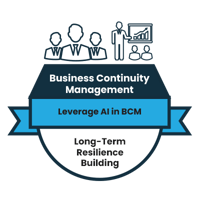Leveraging Artificial Intelligence in Managing BCM
Business continuity management (BCM) has become a cornerstone of organizational resilience in an era of rapid technological advancement and unprecedented global uncertainties.
Companies today face a complex web of risks—from cyberattacks and supply chain disruptions to regulatory changes and climate-related events.
To navigate these challenges, forward-thinking organizations are turning to Artificial Intelligence (AI) to transform how they anticipate, respond to, and recover from disruptions.
This eBook explores AI's multifaceted role in daily BCM operations, breaking its applications into key themes and actionable strategies.
From predictive risk modelling to automated crisis response, AI is not just an efficiency tool—it’s a game-changer for building adaptive, future-ready organizations.
Below, we present a structured overview of critical discussions on integrating AI into BCM and offer insights into how businesses can harness this technology to safeguard operations, stakeholders, and long-term success.
Here’s a structured list of discussions on the use of AI in daily business continuity management (BCM) for organizations, organized by key themes and applications:
1. AI-Driven Risk Assessment and Prediction
-
Real-Time Risk Analysis: Leveraging AI to process internal/external data (e.g., market trends, weather, geopolitical events) for dynamic risk identification.
-
Predictive Analytics: Forecasting disruptions using machine learning models to analyze historical data and emerging patterns.
2. Incident Detection and Early Warning Systems
-
Anomaly Detection: Using AI to monitor IT systems, supply chains, or operations for deviations from normal behaviour.
-
Automated Alerts: Integrating AI with IoT/sensors to trigger early warnings for events like cyberattacks or equipment failures.
3. Automated Response and Recovery
-
Dynamic Playbooks: AI-generated response plans tailored to specific incidents (e.g., rerouting supply chains during a logistics breakdown).
-
Resource Allocation: Optimizing personnel, inventory, or financial resources during crises via AI-driven decision-making.
4. Communication and Stakeholder Management
-
AI Chatbots/Virtual Assistants: Deploying NLP-powered tools to update employees, customers, and partners during disruptions.
-
Sentiment Analysis: Monitoring social media or internal feedback to gauge stakeholder morale and adjust communication strategies.
5. Scenario Simulation and Stress Testing
-
Digital Twins: Creating AI-powered simulations of business operations to test resilience against hypothetical disruptions.
-
AI War-Gaming: Running iterative simulations to refine recovery strategies and identify plan gaps.
6. Supply Chain and Vendor Risk Management
-
Supplier Risk Prediction: AI tools for real-time monitoring of vendor stability, geopolitical risks, or logistics bottlenecks.
-
Alternative Sourcing: Using AI to identify backup suppliers or routes during disruptions.
7. Compliance and Reporting
-
Regulatory Adherence: Automating compliance checks (e.g., PDPA, ISO 22301) through AI audits of BCM processes.
-
Real-Time Reporting: Generating post-incident analysis and compliance documentation via AI.
8. Cybersecurity and IT Resilience
-
AI in Cyber Threat Detection: Identifying and mitigating cyber risks (e.g., ransomware) through behavioural analysis.
-
Automated Backup/Recovery: AI-driven data restoration and system failover processes.
9. Employee Training and Preparedness
-
AI-Powered Drills: Customized training simulations based on historical or predicted risks.
-
Skill Gap Analysis: Using AI to identify workforce vulnerabilities in crisis response.
10. Post-Incident Learning and Adaptation
-
Root Cause Analysis: AI tools to dissect incidents and recommend process improvements.
-
Feedback Loops: Incorporating AI insights to enhance BCM frameworks iteratively.
11. Ethical and Operational Challenges
-
Bias in AI Decision-Making: Addressing algorithmic fairness in resource allocation or risk prioritization.
-
Human-AI Collaboration: Balancing automation with human oversight for critical decisions.
12. Cost-Benefit Considerations
-
ROI of AI in BCM: Evaluating the financial impact of AI adoption versus traditional methods.
-
Scalability: Assessing AI solutions for adaptability across small vs. large organizations.
13. Integration with Legacy Systems
-
Interoperability: Ensuring AI tools work seamlessly with existing ERP, CRM, or disaster recovery systems.
-
Data Silos: Overcoming fragmented data sources to enable effective AI analysis.
14. Long-Term Resilience Building
-
Trend Analysis: Using AI to identify slow-burn risks (e.g., climate change, economic shifts) for proactive planning.
-
Adaptive Learning: Continuous improvement of BCM strategies via AI feedback from past incidents.
15. Privacy and Security Concerns
-
Data Protection: Mitigating risks of sensitive data exposure in AI-driven monitoring/reporting.
-
AI System Vulnerabilities: Safeguarding AI models from adversarial attacks or manipulation.
Summing Up …
Integrating AI into business continuity management marks a paradigm shift in how organizations approach resilience.
By automating risk assessments, enabling real-time decision-making, and simulating worst-case scenarios, AI empowers businesses to move from reactive firefighting to proactive strategy-building.
However, its successful deployment requires more than advanced algorithms—it demands robust data infrastructure, ethical governance, and a culture that balances automation with human expertise.
As this chapter's examples and themes illustrate, AI’s potential in BCM is vast, but its actual value lies in execution.
Organisations that strategically adopt AI-driven tools—while addressing challenges like data quality and workforce readiness—will not only survive disruptions but thrive despite them.
In a world where uncertainty is the only constant, AI offers a path to turn volatility into opportunity, ensuring today's continuity and tomorrow's agility. The future of BCM is intelligent, adaptive, and deeply collaborative—and that future is already here.
| Ensuring Continuity: BCM Best Practices for Frasers Property | |||||
| C1 | C2 | C3 | C4 | C5 | C6 |
 |
 |
 |
 |
 |
 |
| C7 | C8 | C9 |
C10 |
C11 |
C12 |
 |
 |
 |
 |
 |
 |
| C13 | C14 | C15 | C16 | C17 | C18 |
 |
 |
 |
 |
 |
 |
More Information About Business Continuity Management Courses




![Register [BL-B-3]*](https://blog.bcm-institute.org/hs-fs/hubfs/hub_generated/resized/19a8306f-6b76-45ff-8585-95111f393aeb.png?width=200&height=56&name=19a8306f-6b76-45ff-8585-95111f393aeb.png)



![FAQ [BL-B-3]](https://blog.bcm-institute.org/hs-fs/hubfs/hub_generated/resized/9b7f5669-8ad6-450b-a98f-5f5d49ebfc8e.png?width=150&height=150&name=9b7f5669-8ad6-450b-a98f-5f5d49ebfc8e.png)
![Email to Sales Team [BCM Institute]](https://blog.bcm-institute.org/hs-fs/hubfs/hub_generated/resized/83ae9ad3-affc-416e-8f51-64218d6d98f2.png?width=100&height=100&name=83ae9ad3-affc-416e-8f51-64218d6d98f2.png)





